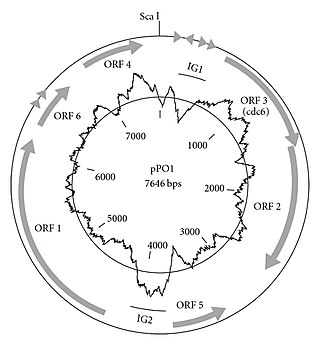Related Research Articles
The Thermoprotei is a class of the Thermoproteota.

The Spirochaetales are an order of spirochete bacteria. Some species within this order are known to causes syphilis, Lyme disease, relapsing fever, and other illnesses.

In taxonomy, the Thermoplasmata are a class of the Euryarchaeota.

In taxonomy, the Thermoplasmataceae are a family of the Thermoplasmatales. It contains only one genus, Thermoplasma. All species within Thermoplasmataceae are thermoacidophiles, and they grow at a temperature of 60 °C and pH 2. They were isolated from hydrothermal vents, fumaroles and similar environments.

In taxonomy, the Thermoplasmatales are an order of the Thermoplasmata. All are acidophiles, growing optimally at pH below 2. Picrophilus is currently the most acidophilic of all known organisms, being capable of growing at a pH of -0.06. Many of these organisms do not contain a cell wall, although this is not true in the case of Picrophilus. Most members of the Thermotoplasmata are thermophilic.

In taxonomy, Picrophilus is an archaean genus of the family Picrophilaceae.

The Desulfurococcales is an order of the Thermoprotei, part of the kingdom Archaea. The order encompasses some genera which are all thermophilic, autotrophs which utilise chemical energy, typically by reducing sulfur compounds using hydrogen. Desulfurococcales cells are either regular or irregular coccus in shape, with forms of either discs or dishes. These cells can be single, in pairs, in short chains, or in aciniform formation.

Sulfolobales is an order of archaeans in the class Thermoprotei.
In taxonomy, the Ferroplasmaceae are a family of the Thermoplasmatales.
In taxonomy, the Methanocaldococcaceae are a family of microbes within the order Methanococcales. It contains two genera, the type genus Methanocaldococcus and Methanotorris. These species are coccoid in form, neutrophilic to slightly acidophilic, and predominantly motile, and they have a very short generation period, from 25 to 45 minutes under optimal conditions. They produce energy exclusively through the reduction of carbon dioxide with hydrogen. Some species have been found in marine hydrothermal vents.
In taxonomy, the Methanocorpusculaceae are a family of microbes within the order Methanomicrobiales. It contains exactly one genus, Methanocorpusculum. The species within Methanocorpusculum were first isolated from anaerobic digesters and anaerobic wastewater treatment plants. In the wild, they prefer freshwater environments. Unlike many other methanogenic archaea, they do not require high temperatures or extreme salt concentrations to live and grow.

In taxonomy, Acidianus is a genus of the Sulfolobaceae.
In taxonomy, Metallosphaera is a genus of the Sulfolobaceae.
Sulfurisphaera is a genus of the Sulfolobaceae.

Haloarcula is a genus of extreme halophilic Archaea in the class of Halobactaria.
Halobiforma is a genus of halophilic archaea of the family Natrialbaceae.
In taxonomy, Methanocorpusculum is a genus of microbes within the family Methanocorpusculaceae. The species within Methanocorpusculum were first isolated from biodisgester wastewater and activated sludge from anaerobic digestors. In nature, they live in freshwater environments. Unlike most other methanogenic archaea, they do not require high temperatures or extreme salt concentrations to live and grow.
In taxonomy, Methanospirillum is a genus of microbes within the family Methanospirillaceae. All its species are methanogenic archaea. The cells are bar-shaped and form filaments. Most produce energy via the reduction of carbon dioxide with hydrogen, but some species can also use formate as a substrate. They are Gram-negative and move using archaella on the sides of the cells. They are strictly anaerobic, and they are found in wetland soil and anaerobic water treatment systems.
Laceyella is a Gram-positive, thermophilic, spore-forming and aerobic bacterial genus from the family of Thermoactinomycetaceae. The genus Laceyella is namened after the English microbiologist John Lacey.
The Coprobacillaceae are a family of Bacillota.
References
- 1 2 Sayers; et al. "Picrophilaceae". National Center for Biotechnology Information (NCBI) taxonomy database. Retrieved 2021-11-17.
- ↑ Anna-Louise Reysenbach; Kristen Brileya (2014-10-19). "The Family Picrophilaceae". In Eugene Rosenberg; Edward F. DeLong; Stephen Lory; Erko Stackebrandt; Fabiano Thompson (eds.). The Prokaryotes. Springer Berlin Heidelberg. pp. 319–321. doi:10.1007/978-3-642-38954-2_326. ISBN 978-3-642-38954-2.
- ↑ J.P. Euzéby. "Picrophilaceae". List of Prokaryotic names with Standing in Nomenclature (LPSN). Retrieved 2021-11-17.
- ↑ "The LTP" . Retrieved 10 May 2023.
- ↑ "LTP_all tree in newick format" . Retrieved 10 May 2023.
- ↑ "LTP_06_2022 Release Notes" (PDF). Retrieved 10 May 2023.
- ↑ "GTDB release 08-RS214". Genome Taxonomy Database . Retrieved 10 May 2023.
- ↑ "ar53_r214.sp_label". Genome Taxonomy Database . Retrieved 10 May 2023.
- ↑ "Taxon History". Genome Taxonomy Database . Retrieved 10 May 2023.